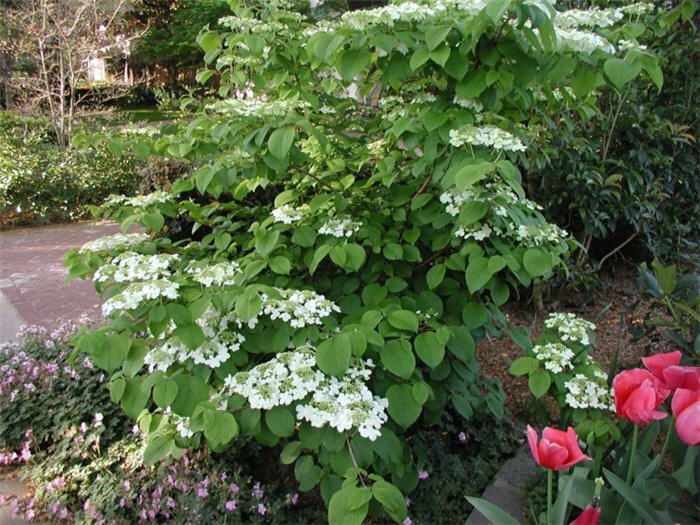| Botanical Name: Viburnum p. var. tomentosum 'Shasta' | |
| Common Name: Shasta Doublefile Viburnum |

-
Anatomy
-
Culture
-
Design
Plant Type
Shrub
Height Range
6-12'
Flower Color
White
Flower Season
Spring
Leaf Color
Green
Bark Color
Brown, Grey
Fruit Color
Black, Red
Fruit Season
Summer, Fall
Sun
Full, Half
Water
Medium, Extra in Summer
Growth Rate
Moderate
Soil Type
Clay, Loam
Soil Condition
Average, Rich, Well-drained
Soil pH
Acid, Neutral
Adverse Factors
n/a
Design Styles
English Cottage, Formal, Japanese, Woodland
Accenting Features
Fall Color, Showy Flowers, Silhouette
Seasonal Interest
Winter, Spring, Summer, Fall
Location Uses
Background, Shrub Border, Foundation, Raised Planter, Walls / Fences
Special Uses
Hedge, Screen
Attracts Wildlife
Birds, Butterflies
Information by: Stephanie Duer
Photographer:
Photographer:
-
Description
-
Notes
'Shasta' is a doublefile viburnum with its spreading, layered horizontal branches. Grows about 10 feet tall and probably wider, and it should be pruned for risk of ruining the lovely horizontal layering. Clusters of pure white, lacecap-like flowers in May are followed by fruit that ripens to red and then black in August and September. 'Shasta Variegated' is a sport with leaves that are margined yellowish green, though in our heat, the variegation is not stable due to stress.
Grow in well drained, loamy soils in full sun to partial shade. Though adaptive to soil types, prefers those that are loamy. Avoid shearing as it ruins the lovely horizontal branching pattern; if pruning is required to control size, do so infrequently and selectively (see guides). V. plicatum is a very similar cultivar, and it seems sometimes as if the two are used interchangeably. The only important difference between the two are that V.p. var. tomentosum blooms a couple weeks later, with the flowers tending to more of a "lacecap" appearance. Otherwise, nearly identical.